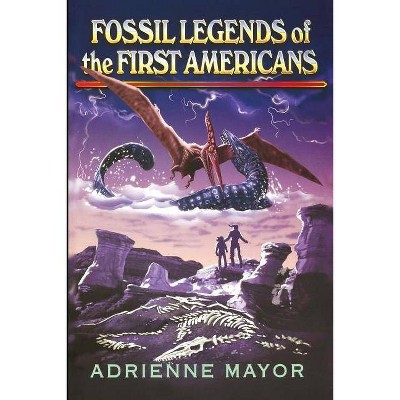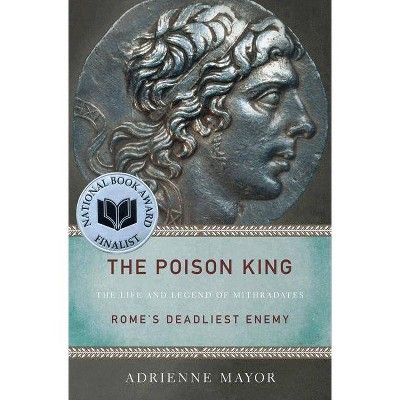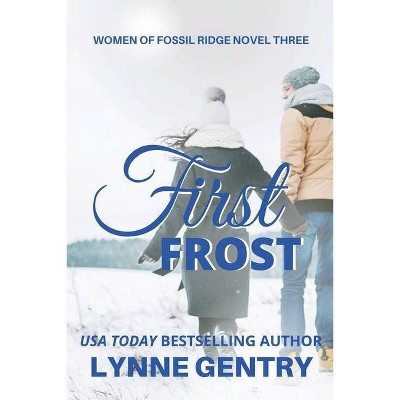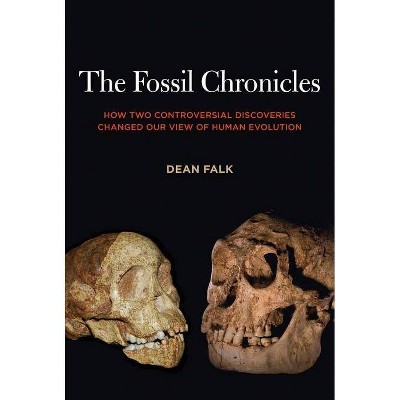The First Fossil Hunters - by Adrienne Mayor (Paperback)
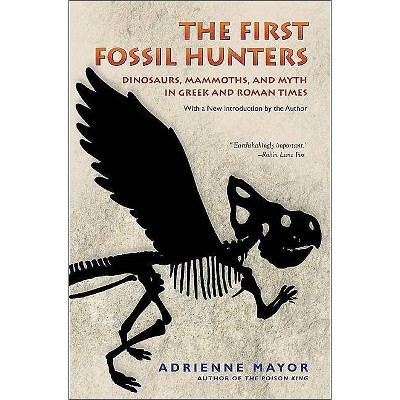
Similar Products
Products of same category from the store
AllProduct info
<p/><br></br><p><b> About the Book </b></p></br></br>Originally published in 2000 with the subtitle: Paleontology in Greek and Roman times.<p/><br></br><p><b> Book Synopsis </b></p></br></br><p>Griffins, Cyclopes, Monsters, and Giants--these fabulous creatures of classical mythology continue to live in the modern imagination through the vivid accounts that have come down to us from the ancient Greeks and Romans. But what if these beings were more than merely fictions? What if monstrous creatures once roamed the earth in the very places where their legends first arose? This is the arresting and original thesis that Adrienne Mayor explores in <i>The First Fossil Hunters</i>. Through careful research and meticulous documentation, she convincingly shows that many of the giants and monsters of myth did have a basis in fact--in the enormous bones of long-extinct species that were once abundant in the lands of the Greeks and Romans. <p/> As Mayor shows, the Greeks and Romans were well aware that a different breed of creatures once inhabited their lands. They frequently encountered the fossilized bones of these primeval beings, and they developed sophisticated concepts to explain the fossil evidence, concepts that were expressed in mythological stories. The legend of the gold-guarding griffin, for example, sprang from tales first told by Scythian gold-miners, who, passing through the Gobi Desert at the foot of the Altai Mountains, encountered the skeletons of Protoceratops and other dinosaurs that littered the ground. <p/> Like their modern counterparts, the ancient fossil hunters collected and measured impressive petrified remains and displayed them in temples and museums; they attempted to reconstruct the appearance of these prehistoric creatures and to explain their extinction. Long thought to be fantasy, the remarkably detailed and perceptive Greek and Roman accounts of giant bone finds were actually based on solid paleontological facts. By reading these neglected narratives for the first time in the light of modern scientific discoveries, Adrienne Mayor illuminates a lost world of ancient paleontology.</p><p/><br></br><p><b> From the Back Cover </b></p></br></br><p>"In this wonderful book, Adrienne Mayor successfully convinces us that some of our most treasured mythical creatures really were based on the skeletons of extinct animals. It is the best account ever concerning the real meaning of mythical creatures. And Mayor has succeeded in setting the history of paleontology on its ear: the art of skeletal restoration was not invented in the western world."<b>--Jack Horner, Museum of the Rockies, author of <i>Dinosaur Lives</i></b></p><p>"Adrienne Mayor's sometimes provocative and always fascinating blend of history, mythology, and science offers a uniquely enriched dimension to the quest for fossils."<b>--Michael Novacek, American Museum of Natural History</b></p><p>"The Greeks were not the only peoples of antiquity to exploit the past in the interests of devising myth and history, but they were among the most ingenious about it, and recorded their views. Adrienne Mayor has uncovered a barely noticed source for many of the myths of the Old World, and for the first time has assembled in an orderly way the evidence for early man's discovery of and explanations for fossil remains. This is a skillful blend of science, history and imagination which adds a chapter to the history of man's ingenuity, from Central Asia to Greece, to Egypt. Many texts, sites, and pictures will never seem quite the same again, after this very thorough and very lively scholarly excursion into a disregarded source of myth-making."<b>--John Boardman, Oxford University</b></p><p>"A brilliant book, full of new insights into the myths and past of the ancient Greeks. Earthshakingly important."<b>--Robin Lane Fox, author of <i>Alexander the Great</i></b></p><p>"An enthralling book. . . . A fascinating account of ancient Greek responses to fossils of extinct mammal species."<b>--David Sedley, author of <i>Creationism and Its Critics in Antiquity</i></b></p><p>"Mayor catches one's attention with her first sentence and doesn't let go until the end . . . In addition to being lively and intelligent, the writing is honest and persuasive. Bringing together classics, archaeology, and paleontology in an original synthesis, Mayor exemplifies in her own research her plea that these fields should profitably confer with one another much more than they do."<b>--William Hansen, Indiana University, Bloomington</b></p><p/><br></br><p><b> Review Quotes </b></p></br></br><br><i>The First Fossil Hunters</i> brings together mythology, art, geology, and paleontology in a convincing manner. . . . Mayor's chronicles do more that entertain; as she contends, they also show that people of Greek and Roman times had a broad understanding of fossils as organic remains of extinct organisms.<b>---Tim Tokary, <i>American Scientist</i></b><br><br>After reading Mayor's <i>The First Fossil Hunters</i> one thing is certain. You'll never look at classical mythology--or at the history of paleontology--the same way again.<b>---Steve Voynick, <i>Rock and Gem</i></b><br><br>Refreshing. . . . Mayor presents her case with an engaging zeal. . . . By the end of the book, you will find yourself filled with enthusiasm for following Mayor's lead in breaking down interdisciplinary boundaries and thus enriching your understanding of the human experience.<b>---Kate A. Robson Brown, <i>Natural History</i></b><br><br>This book is a pleasure to read. . . . The insight into human behavior is enough to attract anthropologists and laypeople to read this fascinating account of paleontology in ancient times.<b>---Deborah Ruscillo, <i>American Journal of Archaeology</i></b><br><br>[Mayor] has done an admirable job . . . [she] easily persuades us that these early writers indeed recorded a palaeontological bonanza centuries before the first dinosaur remains were recognised by modern science.<b>---Richard Fortey, <i>London Review of Books</i></b><br><br>A historical and scientific detective story of first rank. . . . Her results are as striking as they are entertaining. . . . The book will engage specialists with its serious purpose and extensive documentation and will please all readers with its profusion of maps, photographs, and drawings.<b>---Mott T. Greene, <i>Science</i></b><br><br>A surprising account of material overlooked or misunderstood by both historians of science and interpreters of Greek myth . . . [T]his is clear, readable, and convincing.-- "Kirkus Reviews"<br><br>Adrienne Mayor has . . . done some digging deep into the past and found literary and artistic clues--and not a few huge fossils--that seem to explain the inspiration for many of the giants, monsters, and other strange creatures in the mythology of antiquity.<b>---John Noble Wilford, <i>The New York Times</i></b><br><br>Adrienne Mayor's thought-provoking book will mark a watershed in the approach to griffins and giants. . . For both its innovative method and its results, this well-balanced and vividly written book belongs on the bookshelf of every historian of natural sciences.<b>---Liliane Bodson, <i>Isis</i></b><br><br>Classical Corner fans will love the extensive 'Ancient Testimonia' appendix, with quotations on obvious fossil finds from numerous Greek and Roman sources--some so undeservedly obscure that these are their first English translations.<b>---Matt Salusbury, <i>Fortean Times</i></b><br><br>Every classical historian, philologist, or philosopher should know this enlightening work; every library that does not have the 2000-2001 edition should acquire its reissue. An attractive price and excellent presentation ought to make it a good seller to individuals as well.<b>---Victor Castellani, <i>European Legacy</i></b><br><br>In her introduction Adrienne Mayor takes palaeontologists and historians of palaeontology to task. At best there has been accidental ignorance and at worst wilful avoidance and misrepresentation of how much the Greeks and Romans knew about fossils . . . Mayor proceeds to make her case with detailed 'chapter and verse' from the ancients. It is indeed impressive and generally very convincing<b>---Douglas Palmer, <i>Geological Magazine</i></b><br><br>In many ways, this book resembles a detective story. When the author gets on the track of something, she follows it wherever it leads. . . . <i>The First Fossil Hunters</i> will be a revelation to anyone interested in ancient history. For me, it is one of the best books of recent years.<b>---Walter Friedrich, <i>Times Higher Education Supplement</i></b><br><br>Marshaling the array of evidence available from scholarly and popular works, and contributing her own research, Mayor shows that far from ignoring fossils, many Native American groups took great notice of them and developed elaborate myths to explain their origin. . . . Though Mayor is careful not to homogenize native myths, she does note that virtually all of them exhibit a sense of deep time, as geologists call it: an awareness that the world has existed for far longer than humans have walked it.<b>---Eric A. Powell, <i>Archaeology</i></b><br><br>Mayor presents her case with an engaging zeal, describing her sleuthing efforts at length . . . By the end of the book, you will find yourself filled with enthusiasm for following Mayor's lead in breaking down interdisciplinary boundaries and thus enriching your understanding of the human experience.<b>---Kate A. Robson Brown, <i>Natural History</i></b><br><br>Mayor tells a fascinating story of ancient encounters with fossils, setting modern palaeontology beside ancient art and literature.<b>---Helen King, <i>Times Literary Supplement</i></b><br><br>Mayor [combines] the skills of the literary scholar with those of a dinosaur hunter . . . [A]lthough readers will learn a good deal here about the remains of mammoths and protoceratops, they will learn much more about human imagination, that fertile source of science, of legend and of fraud.-- "Booklist"<br><br>Merging the fields of paleontology, archaeology and classical literature, Mayor's research has uncovered striking correlations between modern fossil finds and many of the myths and folklore that sprang up in early Western civilization.<b>---Bryn Nelson, <i>Newsday</i></b><br><br>While the book is aimed at academics and presumes knowledge of contemporary debates on the power of the presidency, it is not too abstruse for the current-events minded reader. . . . And if you're a journalist or author researching the office of the presidency, it's essential.<b>---Lauren Mandell, <i>NationalJournal.com</i></b><br><p/><br></br><p><b> About the Author </b></p></br></br><b>Adrienne Mayor</b> is the author of <i>Fossil Legends of the First Americans</i>; <i>Greek Fire, Poison Arrows, and Scorpion Bombs</i>; and <i>The Poison King</i>, which was a finalist for a National Book Award in 2009. She is a research scholar in classics and history of science at Stanford University.
Price History
Cheapest price in the interval: 18.99 on October 22, 2021
Most expensive price in the interval: 18.99 on November 8, 2021
Price Archive shows prices from various stores, lets you see history and find the cheapest. There is no actual sale on the website. For all support, inquiry and suggestion messagescommunication@pricearchive.us
